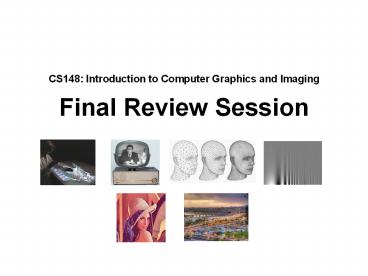CS148:%20Introduction%20to%20Computer%20Graphics%20and%20Imaging - PowerPoint PPT Presentation
Title:
CS148:%20Introduction%20to%20Computer%20Graphics%20and%20Imaging
Description:
CS148: Introduction to Computer Graphics and Imaging. Final Review Session ... on data to make it more amenable to compression (applies to lossless and lossy! ... – PowerPoint PPT presentation
Number of Views:77
Avg rating:3.0/5.0
Title: CS148:%20Introduction%20to%20Computer%20Graphics%20and%20Imaging
1
CS148 Introduction to Computer Graphics and
Imaging Final Review Session
2
Outline
- Final Info
- Review of Topics
- Displays
- Exposure Tone Reproduction
- Mattes Compositing
- Filtering
- Sampling
- Compression
- Digital Video
- Modeling
3
Final Exam Info
- Time Wed, Mar 21st at 1215pm
- Location Building 300, Rm 300
- Duration 2 hours
- Closed book
- Consists of a few (4 or 5) multi-part questions
- All material through modeling lecture
- Emphasis second half of class
- Strongly emphasized material on assignments
- Focus on material from lectures
- Also covered material from readings
- This review covers the second half, see the
midterm review for the first half of the material
4
Displays
- Resolution - Spatial, temporal, and
color/intensity - Interlaced vs. Non-Interlaced (Progressive scan)
- Calibration not all displays have the same
colors, calibrate to match standard (e.g. sRGB)
5
Displays
- CRT electron beam phosphors
- Plasma ionized gas forms plasma
- LCD twisted nematic cells
- DLP fast twitching micromirrors
- Laser Projection
- OLED
- Electronic Ink
6
Exposure Tonemapping
- Contrast MaxMin
- World
- Possible 100,000,000,0001
- Typical 100,0001
- People 1001
- Media
- Printed Page 101
- Displays 801 (4001)
- Typical Viewing 51
10000 1000 100 10 1 .1 .01 .001 .0001
candela/m2 100 Eye 1
Sun Moon Stars
7
Exposure Tonemapping
8
Exposure Tonemapping
- Create HDR Image Weighted log-average based on
input images, shutter speeds, and response curve - Gamma display intensity is non-linear response
to voltage (monitor gamma 2.5) - Perception non-linear as well ( 1/3)
- Tone Reproduction map HDR to displayable range
- Linear map
- Remap through response/gamma
- Log L L / (1L)
- More complicated techniques (separate
luminance/color)
9
Mattes Compositing
- Combine foreground and background objects
- a Coverage
- Area
- Opacity
- 1 Transparency
- CF foreground color, CB background color
- C a CF (1 a) CB
- Premultiplied a C aC (ar, ag, ab, a)
- Pulling a matte blue screen, image processing
a
10
Mattes Compositing
- Blue screen matte extraction
- Given
- C Observed color
- CB Backing color (possibly per pixel)
- Compute
- CF (aFRF, aFGF, aFBF, aF)
- Matte Equation
- C CF (1 aF)CB
- 3 Equations, 4 Unknowns must make some
assumptions
11
Convolution
- Convolution integration/summation of translated
filter with signal
12
Fourier Transform
- Expresses any signal as sum of sin and cos
functions
13
Fourier Transform
Fourier Transform
Spatial Domain f(x,y)
Frequency Domain F(?x, ?y)
Inverse Fourier Transform
Convolution Multiplication Multiplication
Convolution Sinc Box
14
Fourier Transform
15
Fourier Transform Low Pass
16
Fourier Transform High Pass
17
Fourier Transform Band Pass
18
Sampling
- Imagers sample continuous functions
- sensors integrate over their area
- Examples of imagers
- retina ? photoreceptors
- digital camera ? CCD or CMOS array
- Digitally record value of signal periodically
(samples)
19
Nyquist Frequency
- Nyquist Frequency ½ the sampling frequency
- A periodic signal with a frequency above the
Nyquist frequency cannot be distinguished from a
periodic signal below the Nyquist frequency - These indistinguishable signals are called aliases
20
Sampling Spatial Domain
21
Sampling Frequency Domain
22
Undersampling Frequency Domain
23
Reconstruction Frequency Domain
24
Reconstruction Spatial Domain
25
Compression
- Kolmogorov Complexity smallest program to
generate data - Lossless Coding
- Run length coding exploit obvious redundancy
- Huffman Coding variable length code, highly
probable characters -gt shorter codes - Transform Coding perform invertible transform
on data to make it more amenable to compression
(applies to lossless and lossy!)
26
Bases
e1
e2
ae1 be2 (a,b) in this basis
Any vector can be expressed as linear combination
of either basis (pair of vectors)
b2
b1
mb1 nb2 (m,n) in this basis
27
Lossy Image Compression (JPEG)
Discrete Cosine Transform
Quantization (Lossy Step)
Image
Transformed Image
Reorder Coding
Compressed Data Stream
JPEG2000 is similar but uses the wavelet
transform. Exploit human perception quantize
high frequencies more heavily since we are less
sensitive to them.
28
Wavelet Transform
- Just another invertible transform (expresses
signal in different basis) - Generated in steps by calculating smoothed
(approximate) values and detail (corrective)
values - Resulting basis functions have compact support
they are only non-zero over a limited range
error in coefficient causes localized error
29
Wavelet Transform
Full Transform
6.25
High Resolution Details Medium Resolution
Details Low Resolution Details Average Value
30
Video
- Raster scan convert 2D signal to 1D
- Synchronize vertical refresh to swap buffers
- Television Amplitude modulation (next)
- Color TV use amplitude modulation to place
luminance and chrominance signals at different
frequencies - Less responsive to high frequencies in color
- Compression
- I-Frames JPEG Compression
- P,B-Frames Motion predictions encode
difference
31
Amplitude Modulation
32
Modeling
- Representations
- Dense Polygonal Meshes
- Bicubic surfaces
- Subdivision Surfaces
- Operations
- Instancing
- Transformation linear and non-linear
- Compression, simplification
- Deform, skin, morph, animate
- Smooth
- Set operations
33
Bezier Curve
34
Subdivision Surfaces
- Loop subdivision algorithm
- Extraordinary points
- Semi-regular meshes































